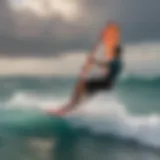Kite Surfing in Tarifa: Your Ultimate Guide
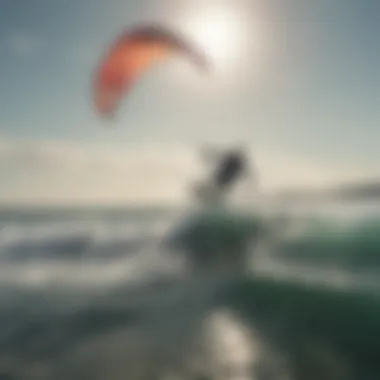

Intro
Kite surfing in Tarifa is more than just a sport; it embodies a lifestyle marked by adrenaline, nature, and community. Known as the wind capital of Europe, Tarifa boasts consistent winds that attract kite surfers year-round. Whether you are a beginner or an experienced rider, understanding the unique elements of kite surfing in this region is essential. This guide aims to cover all facets of kite surfing in Tarifa, providing practical insights to enhance your experience.
Equipment Reviews
Kites
Navigating the variety of kite models can be overwhelming. Recent advancements in kite technology offer better performance and safety. Key features to consider include kite shape, size, and material.
- Shapes : Kites come in various shapes. The most common types include C-kites, bow kites, and delta kites. Each shape affects flying characteristics and maneuverability.
- Sizes : Sizes range from 3 to 17 meters. Choosing the right size often depends on rider weight and wind conditions. Smaller kites handle stronger winds, while larger kites are suitable for lighter wind.
- Materials : Kites are typically made from durable fabrics, such as ripstop nylon. Some brands also focus on environmental sustainability in their material choices.
Popular brands worth considering are North Kiteboarding, Cabrinha, and F-One.
Boards
The choice of board plays a crucial role in the kite surfing experience. Two primary types of boards are available: twintips and directional boards.
- Twintips : These boards are symmetrical and suitable for most tricks and jumps. They are widely user-friendly and perfect for beginners.
- Directional Boards : Ideally used for wave riding, these boards allow for a more traditional surfing experience. They require advanced skills to maneuver effectively.
Analyzing board construction and design for better performance is essential. Pay attention to factors like materials and rocker profile, as they significantly affect riding styles.
Accessories
No kite surfing setup is complete without accessories. Essential kiteboarding accessories include harnesses, lines, pumps, and safety gear.
- Harnesses : They attach the rider to the kite. A personal preference greatly influences harness choice, ranging from seat to waist styles.
- Lines : They are integral in controlling the kite. Check the line strength, length, and material.
- Pumps : Efficient pump systems minimize setup time, which is crucial before hitting the waves.
- Safety Gear : Always wear a life jacket and a helmet. They provide an added layer of protection against falls or unexpected accidents.
Travel Destinations
Popular Spots
While Tarifa is renowned for kite surfing, several spots globally are equally enticing. Locations like Cape Town, Langebaan, and Maui offer excellent conditions. Each place provides unique wind, water conditions, and amenities.
- Cape Town : Characterized by robust winds and scenic views, it’s perfect for all skill levels.
- Langebaan : The flat waters create ideal conditions for beginners.
- Maui : Offers wave-riding opportunities, attracting advanced surfers.
Off the Beaten Path
Sometimes the best experiences are found away from crowded hotspots. Discovering hidden gem locations enhances the adventure. Places such as Zanzibar and Brazil provide unique cultures and landscapes, appealing to adventurous kitesurfers.
Techniques and Tutorials
Beginner Guides
For those starting with kite surfing, focus on mastering the basics.
- Launching : Ensure the area is clear by following a systematic launch protocol.
- Riding : Balance and posture are crucial for effective riding.
- Turning : Learn the art of changing direction smoothly.
- Landing : Practice controlled landings to avoid injuries.
Advanced Skills
Once comfortable, progress to advanced maneuvers. Techniques like jumps, tricks, wave riding, and freestyle improve overall skills. Focus on body positioning and timing for execution.
Safety Guidelines
Weather Conditions
Understanding how wind, currents, and tides influence safety is paramount. Regularly assess local weather patterns and adjust plans accordingly. Familiarize yourself with signs of changing conditions.
Emergency Protocols
Preparation for mishaps is crucial. Know essential safety measures and rescue tactics. Having a first aid kit and a communication device ensures assistance is available in emergencies.
Equipment Maintenance
Regular checks and maintenance help prolong the lifespan of your gear. Inspect kites for tears, ensure lines are unfrayed, and check the functionality of safety features. Maintaining equipment prevents failures while on the water.
"Kite surfing gives you the freedom to explore. Stay safe to enjoy the thrill fully."
This guide serves as an essential resource for both novice and experienced kite surfers. By focusing on the right equipment, understanding safety, and knowing popular spots, an enriching kite surfing experience in Tarifa awaits.
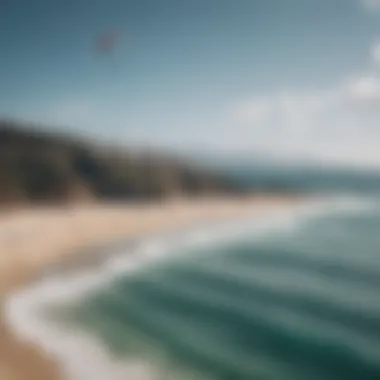

Foreword to Kite Surfing
Kite surfing is a water sport that combines aspects of surfing and paragliding. It has gained immense popularity over the years due to its exhilarating experience and the unique thrill it provides. Understanding kite surfing is essential for anyone looking to embark on this journey. This section outlines the fundamental concepts of kite surfing and its history, setting the stage for a deeper exploration into the kitesurfing scene in Tarifa.
Defining Kite Surfing
Kite surfing is a sport that employs a large controllable kite to harness the wind's power. The rider stands on a board while being pulled across the water by the kite. This action is not as simple as it seems. It requires a good understanding of the wind dynamics, equipment control, and body positioning. Safety is paramount in this sport; thus, knowing basic definitions and concepts is necessary for new and experienced surfers alike.
Some common terms include:
- Kite: The inflatable structure that captures the wind.
- Board: The surface on which the rider stands.
- Harness: The device that connects the rider to the kite, distributing the pull across the body.
- Wind Window: The area in which the kite can be flown efficiently.
The Evolution of the Sport
Kite surfing has undergone significant changes since its inception. The roots of kite surfing can be traced back to the 1960s, but it was not until the 1990s that it gained notable traction. Advances in technology have transformed the sport. Early kites were large and cumbersome, often leading to safety issues. Today's kites are designed to be more aerodynamic and user-friendly, greatly enhancing the safety and performance for riders.
In the early 2000s, the introduction of twin-tip boards revolutionized kite surfing. These boards allowed for easier navigation and maneuverability, which contributed to the sport's rise in popularity. Over the years, kite surfing has also seen the emergence of various styles, including freestyle, wave riding, and racing, each catering to different preferences of surfers.
As kite surfing continues to evolve, so do the communities that surround it. Tarifa, in particular, has grown into a global kite surfing hub, attracting both beginners and seasoned professionals. The evolution of kite surfing is not just about the technical aspects but also the culture and lifestyle that come along with it. Understanding this history can give insight into the wider kitesurfing experience, especially in a vibrant location like Tarifa.
Why Tarifa is a Kitesurfing Paradise
Tarifa, located at the southernmost point of Spain, is widely regarded as a premier destination for kitesurfing. This reputation is not without merit. Several factors combine to make Tarifa exceptionally suited for this sport. Understanding these elements can greatly enhance a kitesurfer’s experience, whether they are beginners or seasoned enthusiasts.
Geographical Advantages
Tarifa's geographical features are pivotal. It sits strategically at the meeting point of the Mediterranean Sea and the Atlantic Ocean. This unique positioning creates diverse water conditions, which can be appealing for kitesurfers at all skill levels. The coastline stretches for approximately 38 kilometers, offering various spots where surfers can find their ideal conditions.
The beaches, such as Playa de Los Lances and Valdevaqueros, provide ample space. This prevents overcrowding, allowing for wider freedom of movement and enjoyment during sessions. The shallow waters near the shore also make it safer for beginners to practice without the fear of deep-water hazards.
Aside from the beaches, Tarifa is surrounded by beautiful natural landscapes. The striking backdrop of mountains provides not only stunning views but also shelter against extreme weather conditions, ensuring that the kitesurfing environment remains enjoyable.
Optimal Wind Conditions
Wind conditions play a critical role in kitesurfing. Tarifa benefits from consistent winds that vary throughout the year, which is a significant draw for kitesurfers. The area experiences both the Levante and Poniente winds, with each providing a distinct kitesurfing experience.
- Levante Wind: This wind blows from the east and can reach up to 30 knots. It often creates flat water conditions, which are ideal for those looking to practice jumps and tricks. It tends to blow stronger in the spring and summer months.
- Poniente Wind: Coming from the west, this wind is usually cooler in temperature and provides a more forgiving experience for beginners. It is typically steadier, and its moderate speed is advantageous for longer sessions on the water.
In summary, the combination of geographical advantages and optimal wind conditions solidifies Tarifa’s status as a kitesurfing paradise. The varied landscape and dependable winds offer unique opportunities for all kitesurfing aficionados. Enjoying these factors can greatly influence a kitesurfing experience, enabling enthusiasts to hone their skills in an ideal environment.
Key Kitesurfing Spots in Tarifa
The significance of identifying key kitesurfing spots in Tarifa cannot be overstated. Each location offers unique wind conditions, wave patterns, and varying atmospheres that cater to different skill levels. Understanding these spots allows kitesurfers to optimize their experience in this premier destination. Whether you are a novice or an expert, knowing the characteristics of each location enhances both safety and enjoyment. Here, we will explore three prominent kitesurfing spots: Playa de Los Lances, Valdevaqueros Beach, and El Balneario.
Playa de Los Lances
Playa de Los Lances is one of the most popular kitesurfing beaches in Tarifa. Stretching over several kilometers, it offers ample space for both beginners and advanced kitesurfers. The wind conditions here are generally stable, making it a reliable choice for kitesurfing throughout the season.
The sandy bottom is another advantage. It is relatively shallow, which gives novice kitesurfers a safe environment to practice without the risk of deep waters. Furthermore, the picturesque setting with its clear waters adds to the appeal. Kitesurfing schools are abundant in this area, providing lessons and rentals. The community atmosphere is welcoming, fostering connections among kitesurfers.
Valdevaqueros Beach
Valdevaqueros Beach is renowned for its stunning natural beauty and consistent winds. This location typically sees the Levante and Poniente winds, ideal for kitesurfing. The beach can get crowded, particularly during the peak summer months. However, there is plenty of room to find a spot to launch and enjoy your kitesurfing session.
The beach is also home to several bars and restaurants, where athletes can relax after a long day on the water. The social scene is vibrant, providing opportunities for kitesurfers to engage with each other. More experienced kitesurfers often prefer Valdevaqueros for its challenging conditions, such as larger waves and varied wind patterns, making it an exciting option.
El Balneario
El Balneario is a unique beach in Tarifa that holds a special allure for kitesurfers. Located near town, it offers easy access to amenities. The waves here can be substantial, providing a thrilling experience for those who seek adventure. The Poniente winds typically blow here, creating ideal conditions for advanced kitesurfers.
While it may not be the best spot for beginners due to its stronger conditions, El Balneario is perfect for those looking to test their skills. The landscape is striking, with its blend of sandy shores and rolling dunes. Many kitesurfing competitions take place here, highlighting its prominence in the kitesurfing community.
"Choosing the right kitesurfing spot is crucial for a safe and enjoyable experience. Familiarize yourself with the unique features of each beach to enhance your skills and confidence."
Understanding the distinct qualities of Playa de Los Lances, Valdevaqueros Beach, and El Balneario equips kitesurfers with the knowledge needed to make informed decisions. Each spot provides different benefits, ensuring that there is something for everyone in Tarifa.
Best Time to Kitesurf in Tarifa
Understanding the best time to kitesurf in Tarifa is crucial for both novice and seasoned enthusiasts. The winds, climate, and crowds play a significant role in optimizing the kitesurfing experience. This section will explore the primary factors that determine the ideal conditions for kitesurfing.
Seasonal Winds
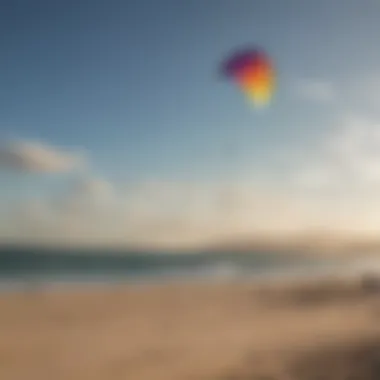

Tarifa is known as the wind capital of Europe, and its wind patterns are essential to kitesurfing. The majority of the year, steady winds make the region a favored location. The prevailing winds in Tarifa are the Levante and the Poniente.
- Levante: This wind comes from the east and is strong, often reaching speeds of up to 30 knots. It usually blows during the summer months from late May to September. Kitesurfers who enjoy high-speed riding will find this wind exhilarating.
- Poniente: In contrast, the Poniente blows from the west and is more consistent during spring and autumn. It tends to be cooler but provides excellent recreational conditions.
The interaction between these winds creates various kitesurfing conditions. Understanding them helps in timing your visits to maximize enjoyment.
Crowd Considerations
Crowd dynamics can greatly impact your kitesurfing experience. During peak tourist season, which coincides with the Levante winds, spots like Playa de Los Lances may become crowded. This can affect safety and the overall enjoyment of the sport.
- May to September: This is the peak season for kitesurfing, particularly due to the reliability of the Levante winds. Expect high foot traffic and multiple schools offering courses.
- October to April: The crowd diminishes significantly. However, wind conditions will still be favorable. Beginners may find it less intimidating to learn during this period.
"Choosing the right time to kitesurf in Tarifa can enhance both safety and the quality of the ride. Each season offers unique benefits."
Equipment Essentials for Kite Surfing
The right equipment is crucial for a successful and enjoyable kite surfing experience. Each piece of gear serves a specific function, whether it's to enhance performance or improve safety. As the sport demands both physical skill and technical proficiency, using the correct equipment can significantly influence a rider's progression and enjoyment in the sport. Understanding the essentials will also help you make informed decisions when purchasing or renting gear.
Choosing the Right Kite
Selecting the appropriate kite is one of the most important decisions a kitesurfer will face. Kites come in different shapes and sizes, and each design caters to various wind conditions and rider abilities. Here are key considerations for choosing a kite:
- Kite Size: The size of the kite must match the rider's weight and the wind conditions. Larger kites provide more power in lighter winds, while smaller kites are suitable for strong winds.
- Kite Type: There are two main types of kites: inflatable and foil kites. Inflatable kites are easier to launch and relaunch in the water, making them popular among beginners. Foil kites, on the other hand, offer increased efficiency and speed, preferred by more advanced riders.
- Aspect Ratio: A kite's aspect ratio impacts its performance. Higher aspect ratios are typically more efficient, providing more speed and lift, but they may require more skill to control. Lower aspect ratios offer more stability, ideal for beginners.
When selecting a kite, it's wise to consult with instructors or experienced riders to determine the best fit for your skill level and local wind conditions.
Boards and Accessories
The board used in kite surfing also plays a fundamental role in performance and comfort. Several factors can help guide your choice of board:
- Board Type: There are two main categories of boards: twin-tip and directionals. Twin-tip boards can be ridden in either direction, making them versatile and ideal for beginners. Directional boards,, often resembling surfboards, are favored by advanced riders for wave riding and speed.
- Board Size: The size of the board should correlate with the rider's weight and skill level. A smaller board is generally faster and more maneuverable, while a larger board provides better stability in choppy waters.
In addition to the boards and kites, accessories are essential for enhancing the kitesurfing experience:
- Harness: A well-fitted harness distributes the kite's pull across the body. There are seat harnesses and waist harnesses, with seat harnesses providing more support and less mobility than waist harnesses.
- Bar and Lines: The control bar with attached lines is critical for steering the kite. Ensure the bar's width and line length match the kite size for optimal control.
- Safety Equipment: Always consider wearing a helmet and impact vest. They provide added protection against falls and harsh conditions.
Overall, understanding the essentials of kite equipment will allow both beginners and seasoned kitesurfers to maximize their time on the water and enjoy the sport safely.
Safety Considerations
Safety is a crucial element in kite surfing, especially in a place as challenging as Tarifa. Knowledge of proper safety practices can significantly mitigate risks associated with the sport. Understanding how various factors like wind conditions and kite control can impact safety helps both novices and experienced kitesurfers to navigate the waves with confidence.
Understanding Wind Conditions
Wind conditions play a fundamental role in kite surfing safety. Each kitesurfer must assess the wind speed and direction before taking to the water. Strong winds can be exhilarating but can also increase the risk of accidents. It’s essential to check reliable sources for up-to-date information about the wind conditions, such as forecast services or local weather stations.
Understanding how different wind types affect your performance is equally important. For instance, onshore winds can be less risky, enabling a safer approach back to shore, unlike offshore winds, which can carry a rider far from the beach. Kitesurfers should also be mindful of sudden wind shifts, which can happen without warning. It’s wise to practice self-rescue techniques should an emergency arise due to unpredictable weather.
- Key Points to Consider:
- Check wind speed and direction before heading out
- Be aware of onshore and offshore wind impacts
- Monitor changing weather conditions
"Preparation is the key to safety. Knowing the wind is half the battle in kite surfing."
Kite Control Techniques
Kite control is another safety aspect to consider seriously. Mastering your kite increases not just your enjoyment but also your safety in the water. Understanding how to steer and maneuver the kite effectively allows for better reactions during sudden changes in wind. Learning to depower your kite when needed can avoid potential accidents.
Involvement in a series of practice runs, both on land and in controlled water settings, can help refine these skills. Control can also depend on the size and model of the kite. While some kites are designed for stability, others are geared more towards performance, which may require advanced control skills. Therefore, choosing the right kite is pivotal, especially for beginners.
Consider honing skills like:
- Launching and landing the kite safely
- Executing smooth turns and transitions
- Maintaining proper distance from other riders
In summary, the safety considerations for kite surfing in Tarifa are multi-faceted. By understanding wind conditions and perfecting kite control techniques, practitioners can enjoy a thrilling experience while minimizing risks.
Learning to Kitesurf in Tarifa
Kite surfing is a skill-based sport, requiring both physical and mental acuity. Learning to kitesurf in Tarifa is essential for those who want to take fully advantage of the unique wind conditions and beautiful beaches the area has to offer.
Starting this journey offers numerous benefits. First, it connects beginners with experienced instructors. These professionals provide a structured learning approach. They ensure safety, knowledge of equipment, and understanding of the local environment.
Additionally, Tarifa offers a community of like-minded individuals. This fosters an atmosphere of encouragement and camaraderie.
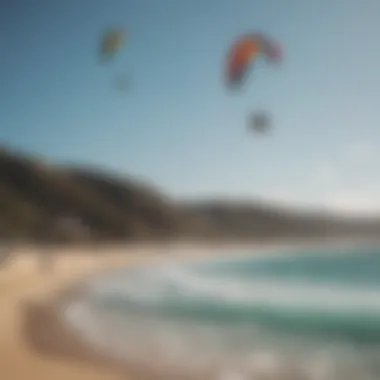

Kitesurfing Schools
In Tarifa, several reputable kitesurfing schools cater to varying skill levels. These schools adhere to international teaching standards. Furthermore, they employ certified instructors who understand the local conditions. Here are some well-known schools in the area:
- Kite Paradise Tarifa: Renowned for personalized lessons and small group sizes.
- Tarifa Kitesurfing School: Offers a broad range of classes from beginner to advanced levels.
- KiteSurf Tarifa: Specializes in intensive training programs.
Most of these schools provide full equipment rentals which makes it easier for beginners. This is important because new enthusiasts can try different gear before making a purchase.
Beginner Classes vs. Advanced Training
The choice between beginner classes and advanced training depends mainly on individual skill levels.
Beginner classes focus on teaching the fundamentals:
- Safety protocols
- Kite theory
- Basic flying techniques
- Water starts
Through these classes, newcomers learn to control the kite effectively.
Advanced training is for those who have already grasped the basics. These sessions delve deeper into tricks, jumps, and racing techniques. Instructors focus on optimizing skills and enhancing performance.
Also, advanced training typically includes personalized coaching and video analysis to improve techniques. This is crucial for those wanting to compete or push their limits.
Kite surfing in Tarifa can be a pinnacle experience. Whether starting as a novice or enhancing skills, the area provides ample opportunity for both.
Local Culture and Community
The vibrant culture and strong community are significant dimensions that accompany kite surfing in Tarifa. The sporting environment is not just about riding the waves; it encapsulates the lifestyle of the locals and the visitors alike. Understanding this intertwining of sports and culture enriches the overall experience for participants. In Tarifa, there exists an unusual harmony where kitesurfing merges seamlessly with daily life, creating an engaging atmosphere for everyone involved.
Intertwining of Sports and Local Lifestyle
In Tarifa, kitesurfing is more than just a sport; it is a part of everyday life for many residents. The beaches are often filled with kite surfers at dawn and dusk, creating a spectacle that locals have grown accustomed to. This shared passion fosters a sense of community that transcends traditional boundaries. The inhabitants of Tarifa, be it shopkeepers, instructors, or casual beachgoers, have a common language centered around the surf and wind conditions.
The local businesses, from cafes to rental shops, often cater specifically to the surfing community. This interaction highlights an important element of local culture — the symbiotic relationship between service providers and sports enthusiasts. When tourists come to kite surf, they often engage with these local businesses, enhancing the support for the community. The sharing of stories and experiences after a day on the water is a common occurrence and contributes to a strong sense of belonging among kite surfers.
Events and Competitions
Throughout the year, Tarifa plays host to numerous kite surfing events and competitions that amplify its cultural backdrop. These events attract not just local talent but also international athletes. Such competitions bring up the level of excitement and foster camaraderie among all participants.
The annual Tarifa Kite Festival, for instance, showcases a mix of thrilling sport and cultural celebrations. It features not only various competitions but also workshops and demonstrations for those looking to improve their skills. These gatherings allow for knowledge exchange, where seasoned kite surfers share techniques and insights with novices. They also present opportunities for networking within the kite surfing community.
Moreover, these events often incorporate local music, food, and art, immersing participants in the region's culture. This blending of kitesurfing and local festivities enriches the experience, making it memorable for everyone involved. The thrill of competition paired with cultural engagement exemplifies what Tarifa stands for in the global kite surfing community.
The community culture in Tarifa is profoundly influenced by kite surfing, creating a unique blend of sport and lifestyle that resonates with both locals and visitors alike.
Sustainability and Environmental Practices
Sustainability is increasingly becoming a crucial aspect of kitesurfing in Tarifa. As the sport gains popularity, so does its impact on the coastal environment. Emphasizing sustainability helps protect the natural resources that make Tarifa a kitesurfing haven. This section explores the importance of sustainable practices in kitesurfing, focusing on specific conservation efforts and the ecological balance necessary for preserving local beauty.
Conservation Efforts
Efforts to conserve the environment have become more prominent in the kitesurfing community. Local organizations and clubs are spearheading initiatives aimed at preserving the beaches and water quality. Here are some notable actions being taken:
- Beach Cleanups: Community-led beach cleanups happen regularly. These events not only remove garbage from the shoreline but also raise awareness among kitesurfers and the public about keeping the environment clean.
- Partnerships with Environmental Groups: Some kitesurfing schools partner with organizations like Save the Waves Coalition. These partnerships aim to implement sustainable tourism practices that minimize ecological footprints.
- Awareness Campaigns: Workshops and seminars focus on educating kitesurfers about the local ecosystem. Understanding the balance of marine life encourages respectful usage of the sea and beaches.
These concerted efforts are vital in ensuring the ongoing appeal of kitesurfing in Tarifa by preserving its pristine landscapes and rich biodiversity.
Impact of Kitesurfing on Local Ecology
While kitesurfing is an exhilarating sport, it can pose challenges to local ecology if not practiced responsibly. Here are some effects to consider:
- Disturbance to Wildlife: The presence of kitesurfers can disturb sensitive marine habitats, particularly during certain breeding seasons. Birds and marine life may alter their natural behaviors to escape noise and activity.
- Navigational Hazards: When large numbers of kitesurfers are active in one area, it can lead to congested waters. This raises concerns about the safety of marine creatures and the surfers themselves.
- Pollution: Equipment waste, such as broken boards or damaged kites, contributes to pollution. Proper disposal and recycling of equipment are essential to mitigate this issue.
"Kitesurfing should not compromise the health of Tarifa's natural environment. It requires a collective responsibility to preserve what draws us here in the first place."
In summary, the sustainability of kitesurfing in Tarifa involves recognizing and managing its environmental impact. By understanding the importance of conservation efforts and being aware of potential ecological issues, kitesurfers can enjoy the sport while safeguarding the coastal ecosystem for future generations.
Finale
In concluding this guide, it is essential to recognize the multifaceted nature of kite surfing in Tarifa. This region, known for its excellent weather conditions and majestic landscapes, presents a unique environment for both novice and seasoned kitesurfers. The conclusion not only encapsulates the key points discussed throughout the article, but also emphasizes the rich blend of adventure and community spirit that kite surfing fosters.
Summary of Key Points
The pivotal elements that define kite surfing in Tarifa have been addressed, including:
- Geographic Advantages: Tarifa's strategic location enhances wind availability, crucial for kite surfing.
- Optimal Wind Conditions: The consistent and strong wind patterns present during the peak seasons make it an ideal place for this sport.
- Equipment Essentials: Choosing the right kite and accessories greatly impacts performance and enjoyment.
- Safety Considerations: Understanding the wind and mastering kite control techniques significantly reduce risks.
- Local Culture: The strong connection between kitesurfing and local lifestyle adds to the charm of Tarifa, promoting a sense of community.
- Sustainability Efforts: The importance of environmental conservation practices ensures the local ecology remains intact amid rising tourism.
These points highlight why Tarifa stands out as a premier kitesurfing destination and underline the various aspects that contribute to a fulfilling experience in the water.
The Future of Kitesurfing in Tarifa
Looking ahead, Tarifa's kitesurfing scene is poised for continued growth. With advancements in equipment technology, better safety practices, and an increasing awareness of environmental sustainability, the future appears promising. Furthermore, initiatives to promote eco-friendly kitesurfing practices may shape the way this sport is enjoyed in Tarifa. The integration of local culture and events will continue to attract not only tourists but also seasoned kitesurfers seeking an authentic experience. As the community nurtures new riders and fosters experienced athletes, the landscape of kite surfing in Tarifa will likely evolve, remaining vibrant and distinctive in the global kitesurfing arena.
